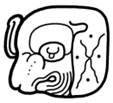| CMGG entry for syllabogram tz'o
|
|
Variant: abstract
K&H = K&L = 25EMC = FK2 TOK.p34.r4.c1 BMM9 = CMC4
|
|
Variant: rabbit head [Same examples as for pe]
K&H TOK.p31.r1.c4 T759a&b M&L.AP7
· Lopes-ANLatNPotSL.p2 (2005): There is some evidence that the rabbit head (T759) at [13] may be a syllable with a value /tz’o/ (Stuart 1999:173-174). The transitive CVC root kotz’ has the meaning of “to roll, wind, wrap” in some Maya languages such as Ch’olti’ (Moran 1935) and Colonial Yucatec (Vásquez 2001:339). A syllabic value of /pe/ has also been proposed for this glyph which is productive in some contexts. Curiously, both roots kotz’ (Vásquez 2001: 339) and kop (Vásquez 2001: 336) have similar meanings in Colonial Yucatec [= to roll, wind, wrap]. · Gronemeyer&MacLeod-WCHi2021 (2010) provides a detailed argument for a possible alternative (i.e. additional) reading of the rabbit head glyph as tz’o (possibly arising from the merger of two formerly distinct glyphs) – Gronemeyer&MacLeod-WCHi2021.p54.fn57: We prefer the reading /tz’o/ for the sign AP7 first proposed by David Stuart (Stuart, Houston & Robertson 1999: II-52) for the "Snake Lady" conjuring scene on K5164; he reads the whole as Ix Tzak Kotz'-om Chan: ‘she who conjures/grasps the rolled-up snake’. This kotz'-o:m ‘winder snake’ (the term we prefer) is likely to be the same being owned by Ihk' Mu:y Muwa:n in his parentage statement, as will be explained. The /tz'o/ reading for this animal head does not seem to work in all instances, as in the Codex Dresden pp. 4a-10a, where the productive reading /pe-ka-ja/ for pehkaj (t-u chich) ‘it is spoken (in his prophecy)’ appears (Schele and Grube 1997: 96, who offer a translation ‘he reads’). Beliaev (2004: 122, fn. 1) has proposed /ko-pe-ma/ for the snake in this Snake Lady scene, yielding a nearly identical meaning kop-em ‘rolled up’. But we observe that the Ch’olan perfect participle -em is all but absent from the script, while the agentive -o:m abounds. Additionally, a participle *u-kop-em with no modified noun following (as we have at K2) seems unlikely, whereas a possessed agentive u-kotz’-o:m works well here. We speculate that two distinct signs merged creating a default bivalence for AP7. · The rabbit-head is listed as pe but not as tz’o in any of the (post-2010) syllabogram tables of the “printed” reference / pedagogical works (up to K&H in 2020). Bonn also does not list the rabbit-head with a reading of tz’o. So the Stuart 1999 proposal hasn’t perhaps met with much support. · Sim: it would appear that MHD is in favour of pe (for K5164).
|






